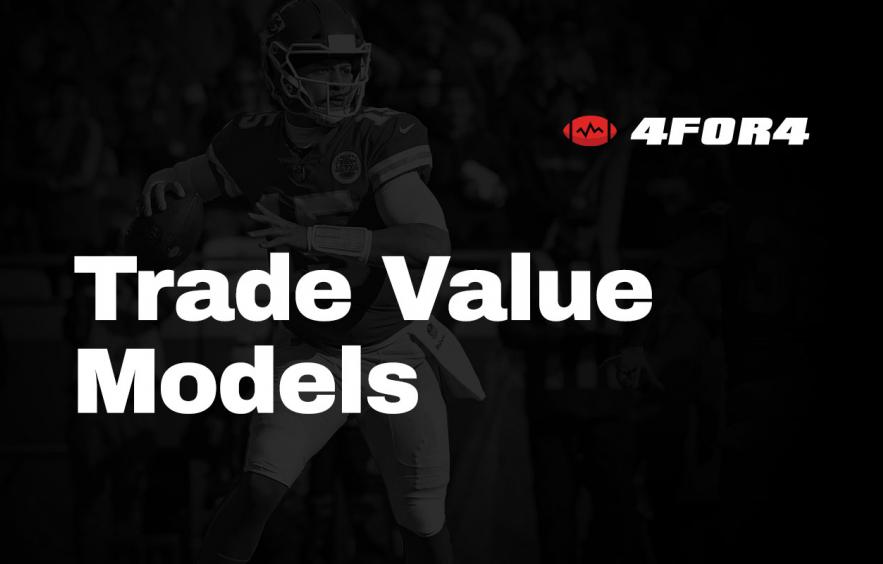Fantasy Football Trade Value Models: What, Why, How, and Who Cares

Trading makes fun. I believe that besides maybe the draft, trading is the most fun activity in all of fantasy football. Obsessively staring at your team to look for strengths and weaknesses. Scrolling through your league mates' rosters looking for a good match. That is peak fantasy football. My goal is to make trading even easier and more fun for everyone.
I have been building trade value charts since 2017. My background is in engineering and data analysis, so naturally, I booted up excel and tried to apply what I knew to fantasy football. Over the last several years that hobby has turned more into an obsession. And here we are, together.
My goal with this is to help everyone understand a little bit more about what a trade value chart is, how I build them, why I build them the way I do, and who cares or who should be using them. I am excited to be working with the experts here at 4for4 and I hope you all are excited to see the in-season trade value charts that will be here exclusively!
Other Strategy Primers: When to Draft a Running Back | Running Back Handcuffs | Tight End Strength of Schedule Beneficiaries | How to Stream Your Fantasy Defense
What is a Trade Value Chart?
A trade value chart is a tool that should be used to gauge if a trade is relatively even/fair or to look for potential trade targets. Trade values convert fantasy football players into a consumable numeric value to create a common vernacular. The goal of most trade value charts is to capture the market value of a player in a vacuum.
The charts I will be posting here will have a twist! I will be generating trade values using only the highly rated projections here at 4for4 and comparing them to the market. This will allow subscribers the unique opportunity to look for market discrepancies versus their peers and will help improve this model that I have used in the past.
Why Do I Build Trade Value Charts?
In 2017, I was lurking on Reddit reading the comments on a popular trade value chart and noticed some weaknesses. I found that most trade value charts have a hard time with cross-positional values and with quantifying value at the top and bottom. I started to build my own to correct these issues and to get a better handle on the market. I knew I wanted a tool to help me with my home leagues and that is how it all began.
How Do I Build Them?
I started my journey by going through hundreds of trades on weekly player trade threads from Reddit to find “even” trades focused on one-for-one positional swaps. I wanted to calibrate the value of wide receivers, tight ends, and quarterbacks in terms of running backs. The basis for my analysis is that running backs are the currency or backbone of a fantasy football roster (in one-quarterback leagues.) Running backs are by far the rarest and greatest positional need, so I wanted to use their values as the basis of everything.
I looked for one-for-one trades because trades with lopsided players (example: three-for-one) make the math much more difficult. From there I was able to write relationships for wide receivers in terms of running back values and the same for the other positions. I also use wide receiver to tight end and wide receiver to quarterback relationships to calibrate weekly data, but with a much lower weight factor. From this historical data, I wrote a series of functions that I use to predict future trade values based on a weekly input.
I round all player values to 0.5 to help with math and to account for significant digits. Standard scoring or 0.0 point per reception (PPR) is the bases of the model. To generate full-PPR and half-PPR rankings I built a PPR correction database that assigns each player a correction that is a function of their targets, catches, team pass attempts, etc. Quarterbacks and defense and special teams (DST) always have a PPR correction of 1. The half-PPR trade values are an average of the standard and PPR trade values.
Calibration is key for any model, so I regularly look at one-for-one positional trades in publicly available sources to adjust the established functional relationships. Recently, we have seen a decreasing trend in wide receiver value when compared to running backs, and high-end tight end value increased due to scarcity. It will be interesting to watch the trends over the coming years.
Step one in understanding my methods is to look at the assumptions. All my algorithms and player-specific qualifiers are based on some fundamental assumptions. All other scoring methods are variants of my analysis based on these assumptions and calculated relationships. The assumptions are:
- 12-team league size
- 1 QB, 2 RB, 2 WR, 1 TE, 1 Flex (TE/RB/WR), 1 DST, and 1 Kicker
- Standard Scoring (STD); Decimal Scoring
- No points per reception
- 10 yards rushing per point
- 25 yards passing per point
- Rushing TD = 6 Points
- Passing TD = 4 points
Who Cares?
I am hoping you care. Anyone that wants to help improve trading in their fantasy football leagues should care. Trade value charts are a starting point in a conversation that only you and your leaguemates can have. All of us here at 4for4 just want to help make that conversation a little smoother and more enjoyable.
I hope you will tune in each week to check out the charts. I am excited that football is almost here.

















